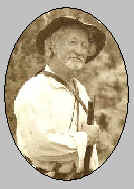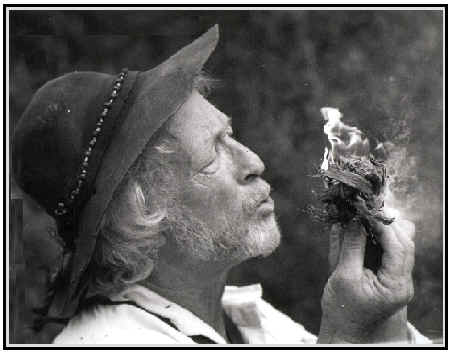|
Smoke Signals Mar/Apr 2012
|
||
|
BILL
CUNNINGHAM |
Blowin' Smoke
|
|
|
Blowin' Smoke
WERE ONLY TRAPPERS “MOUNTAIN
MEN”?
History records quite a number of men who, during the fur trade years, traveled to the Rockies yet never belonged to a fur brigade, were not considered free trappers, and never worked as trappers for the HBC or the AMC. From time to time they may have done some trapping, but if so it was only for lack of something else to do, was not done in employment for anyone but themselves, and lasted but for a short while. Men such as Miles Goodyear, James Kipp, and Mathew Kinkead fit in this category. I’m betting that of the three you have only heard of Miles Goodyear, even though he died at the fairly young age 32 and the others lived long lives. Such are the vagaries of history and circumstance. During his life Mathew Kinkead
was later perhaps best known for, at his home in Taos, taking in the
young Kit Carson shortly after Carson had taken leave of an abhorred
apprenticeship back east. Perhaps because of Carson’s later
reputation Kinkead, who had a life of broad experiences in the
southwest, became generally known only for his hospitality. But he
was much more than that. James Kipp, on the other hand,
never spent time in the southwest. He originally came from near
Montreal. Beginning about 1808, when he was 20, he worked as a
hunter and trapper in the Red River region but evidently on his own.
By the time he was thirty he was on the upper Missouri working for
the Columbia Fur Company as an agent. This was in 1822 and a year
later, still as an agent, he went up the Missouri to the Mandan
villages. Kipp was known as an educated man. Supposedly he was the
only white man to learn the Mandan language and it was here near the
Mandans that he earned the reputation as a builder of fur-trading
posts—fort structures designed as much for protection as for
trade. In 1826 a man named Tilton arrived and took charge of the
post and Kipp went up to the mouth of the White Earth River and
built another post. While Kipp was maturing and
then building posts, Mathew Kinkead was doing some growing of his
own. Hauled along by his father, David, and in company with his
step-mother and seven siblings, from Kentucky to the Femme Osage
River in Missouri in 1803, and shortly after to the forks of the
Charette to a land-grant from the governor. In 1809 the grant was
rescinded for some unexplained reason, and David took the family to
Boone’s Lick. When the War of 1812 broke out the Kinkead family
got to live in close quarters in forts with many others, some who
became quite famous in the history of the west: people like Josia
Gregg, William Wolfskill, Kit Carson, James Cockerell, Stephen
Cooper (who opened the trade with Santa Fe in 1821), and many others
who later became Santa Fe traders. David Kinkead built a fort on the
Missouri River and 29 men and boys survived the three years of war
there, having many skirmishes with the Indians. By 1828 the Columbia Fur
Company had merged with the American Fur Company and Kipp was hired
by the company to build Fort Floyd, later Fort Union. He stayed
there until early 1831. During that time he built Fort Clark by the
Mandan villages. The following winter he built Fort Piegan among the
Blackfeet above the mouth of the Marias River. But despite his post/fort
building, Kipp’s major assignments, however, seemed to have been
to take furs and skins gleaned from the Indian trade down the river
to St. Louis each year from whence he turned around and went back to
Indian country. Usually, when he arrived there, he was put in charge
of one or more of the Company’s posts, By December of 1830, Kinkead
was a naturalized citizen of Mexico and still operating the whiskey
mill. However, in late 1835, he received a land grant of two hundred
varas of land in the Santa Gertrudes valley (present Mora, New
Mexico). Here he settled for a time. During this period he began
keeping house with a strikingly beautiful woman, Maria Teresa (Teresita)
Suaso, With this strong willed and jealous mate he had two children.
By 1841 had left Mora and moved to the present site of Pueblo,
Colorado. In the spring of that year, Dick Wooten drove a flock of
Kinkead’s sheep to what is now Kansas City (Westport at the time)
and sold them. Things get a bit cloudy here, but perhaps the two
used the profits to go into the buffalo business. Wooten caught up
nearly 50 buffalo calves and turned them in with a corral full of
cows. When the calves were three years old, Wooten drove them back
to Westport and sold them. For a while there was a terrific market
for what back east were interesting novelties. By 1841, Kipp was stationed at
Fort Union where he was met by Father deSmet. The priest noted that
Kipp was the principal administrator there and was favorably
impressed by him. John Audubon and Ed Harris met him and described
him as one of the partners of the Upper Missouri Outfit. This was in
1843. Kipp provided Audubon with lots of specimens and information
about the area. He left them to travel up the Yellowstone to take
charge of Fort Alexander but by 1846 he was back in charge of Fort
Union. He met there Charles Larpenteur who was then out of work. In the spring of 1849 Kinkead,
in company with John Brown, Jim Waters, and others, moved to
Sacramento where he became quite wealthy. He owned ships, land and
haciendas. Just when he died is not noted, but in 1878 his son
Andres (now Andrew) went back to New Mexico to sell his father’s
Mora Grant land, some lots in Taos, and some property in Salt Lake
City. While in New Mexico he visited his 91 year old mother. She
died the next year. Probably still cranky. Kipp left the fur trade about
1865 and moved to his farm in Missouri. In July, 1880 he died and
was buried at Parkville.
Bill Cunningham NAF #006 |
||



